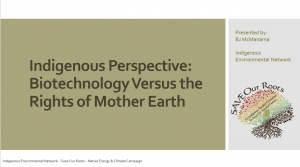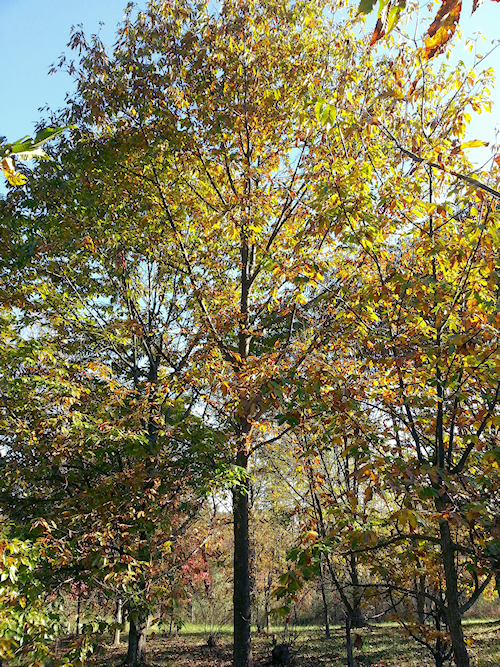NO GE Trees in our wild forests…
One More Time! Deadline January 26, 2023
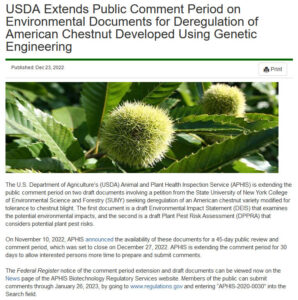 Please consider submitting a comment opposing the granting of non-regulated status of the genetically engineered American chestnut tree “Darling58” (GEAC-D58).
Please consider submitting a comment opposing the granting of non-regulated status of the genetically engineered American chestnut tree “Darling58” (GEAC-D58).
The unregulated and intentional release of GE trees in the US would irreversibly contaminate wild forests and threaten successful restoration efforts projects focused on wild trees in the US and Canada.
Long term impacts to ecosystems and human health from GE trees that can live for 100s of years are completely unknown and threaten forests impacted by logging, introduced pests and pathogens, urban sprawl, and climate change. It is a “massive, irreversible experiment” with our forests.
You can find more information and the questions that remain unanswered on this page that we are submitting to the USDA.
Click here or the Image above to submit your comments to this petition for nonregulated status. (Regulations.gov. to view the DEIS and DPPRA)
We oppose the nonregulated status of the genetically engineered American chestnut tree: Darling58 (GEACD58) for the following rationality:
- It is dangerously presumptive that a single gene construct, the oxalate oxidase enzyme (OxO) from wheat will lead to conferring durable blight resistance. The outcomes have shown that engineering resistance to one pathogen, often leaves plants more susceptible to other pathogens or stresses, or reduces plant growth significantly and over time pathogen resistance becomes less effective or not effective at all.
- Because the intention of the release of this genetically engineered tree is to spread in the wild, across the full range of the American chestnut, the unconfined release of DEAC D58 trees represents, by definition, a plant pest risk as a potential invasive. This spread of Darling 58 is intended to occur across many ecosystems and landscapes including in Canada.
- A decision to permit release of this GE tree would set a dangerous precedent for the release of other genetically engineered/modified GE/GMO trees into the wild as well as the deregulation of other species and variants of GE trees, where cumulative environmental impacts are likely to increase over time. There has been no consideration of the potential threats and negative impacts that would result in these environments. No life form within biological regions or the entire earth for that matter, lives in isolation and therefore altering the genetic code of multiple living entities within a region has the potential to severely limit or eliminate the vital biological interactions that have been established for countless millennia.
- There is no evidence only assumptions that the OXO trait will continue to be viable over time and multiple generations of progeny that may or may not have carried this gene or what mutations might have occurred that wouldn’t be known in the less than a decade that D58 has been cultivated and studied. This short time span is insignificant when considering the age and maturation of existing bio regions that are measured in countless centuries. me span .
Our position on genetic engineering is grounded in our Traditional Indigenous Knowledge (TIK) that serves to support and direct the work toward universal understanding of and our adherence to the natural laws that maintain earth’s biodiverse relationships of all living beings. As Indigenous Peoples, our responsibility is to adhere to our sacred relationship to nature’s original instructions within these constructs. As humans, with our fragmented understanding of these complexities, we identify these instructions in the context of DNA.
Our position is solidly grounded in the indisputable truth that no life form lives in isolation, given the countless complex relationships above, on, and below the surface of Mother Earth. And because humans lack the depth of knowledge of these highly complex and far reaching relationships, we are compelled to do all we can to prevent the purposeful release of the GEAC and generally the manipulation of DNA that will facilitate any manner of ownership, commodification, and control of living entities.
There are far too many examples of genetic manipulation for applications that has and continues to contribute to a 65% population decline in pollinators across the world for so-called modern industrial agriculture operations. These genetic manipulations include resistance to chemicals, promotes accelerated growth, pest and pathogen resistance, and for cultivation in non-native environments. These applications and uses have caused unintended and dramatic negative impacts to biodiversity, human health, and countless other non-target life forms.
One of the more prominent arguments by researchers is the traditional or old methods of breeding resistance into this tree is taking too long – but we should have learned by now that mistakes are made by moving too fast. Restoring this tree into our lives and forests is important work and means a lot to many, so let’s take our time and do it right.
There has been significant work done breeding blight resistance to the American chestnut using traditional breeding processes with related tree species that have a natural immunity to the blight. This process is a more measured and responsible and it has shown great promise.
You’re welcome to use the information we’ve provided in your own comments. There is much more information on the page below to include evidence of the efficacy of using traditional plant breeding methods and examples of American chestnut hybrids thriving despite the false narratives being projected by proponents of taking shortcuts that will not serve us and future generations.
NOTE: It is best to write your comments in your own way, your reasons for preserving the genetic integrity of our forests and the biodiversity that remains. We thank you in advance for consideration of our request and the time you’ve taken to submit your comments.
ADDITIONAL OUTREACH AND EDUCATIONAL INFORMATION FROM OUR WORK OVER THE YEARS:
Groups Across North America Oppose Release of Genetically Engineered Trees
New York- On Oct. 19th the initial public comment period by the United States Department of Agriculture (USDA) on the petition for deregulation of Darling 58 genetically engineered (GE or genetically modified) American Chestnut closed. However, this is not the last step for the final decision and there will be another opportunity for submitting comments. We anticipate there will be an Environmental Impact Statement produced, which will include meaningful consultation with Native American tribes and Peoples throughout the region where these GE chestnut trees once stood tall in the eastern U.S. and Canada.
Shortly after the close of the comment period, representatives of five organizations opposing the deregulation of Darling 58 spoke at a virtual press conference: Anne Petermann–International Coordinator, Campaign to STOP GE Trees; BJ McManama–Campaign Organizer, Indigenous Environmental Network; Scot Quaranda–Communications Director, Dogwood Alliance; Dana Perls–Food and Technology Program Manager, Friends of the Earth; and Lucy Sharratt–Coordinator, Canadian Biotechnology Action Network.
Read: Public Comment on Darling 58 American Chestnut Closes
Groups Across North America Oppose Release of Genetically Engineered Trees
New York- On Oct. 19th the initial public comment period by the United States Department of Agriculture (USDA) on the petition for deregulation of Darling 58 genetically engineered (GE or genetically modified) American Chestnut closed.
Historically, there has been strong public opposition to GE trees, a trend which continues to be seen with the current proposal. The public comment period closed with 109 organizations, representing millions of members, officially opposed to the proposal to plant Darling 58 in forests. 123,426 individuals have also registered opposition to the genetically engineered American chestnut. More than 400 organizations have previously endorsed a full global ban on the release of all GE trees into the environment.
Today, representatives of five organizations opposing the deregulation of Darling 58 spoke at a virtual press conference: Anne Petermann–International Coordinator, Campaign to STOP GE Trees; BJ McManama–Campaign Organizer, Indigenous Environmental Network; Scot Quaranda–Communications Director, Dogwood Alliance; Dana Perls–Food and Technology Program Manager, Friends of the Earth; and Lucy Sharratt–Coordinator, Canadian Biotechnology Action Network.
The representatives spoke against the attempt by researchers at the SUNY College of Environmental Science and Forestry (ESF) to gain regulatory approval for “Darling 58,” a GE American Chestnut for unrestricted planting in North American forests, making it the first genetically modified organism (GMO) designed to spread into ecosystems.
Speakers in order of their presentation:
Anne Petermann, Global Justice Ecology Project: “There are no long-term risk assessments of the impact of these GE trees on ecosystems. This would be an irreversible experiment. The Precautionary Principle mandates that before such an irreversible action is taken, it must be proven safe. There is no evidence that the GE American chestnut tree is safe in forest ecosystems over time. Corporate backers like Monsanto, ArborGen, and Weyerhaeuser view the chestnut as a ‘test case’ to overcome widespread public opposition to GE trees. They are hoping to open the door to other GE varieties like poplar and pine designed for industrial plantations.”
Dana Perls, Friends of the Earth: “The release of genetically engineered chestnut trees could have irreversible and unpredictable impacts on vulnerable forest ecosystems. This biotech proposal is part of the decades long agribusiness agenda to maximize profits and control of nature at great cost to our health and the planet.”
BJ McManama, Indigenous Environmental Network: “Today, there remain large areas of traditional and treaty lands on which much is forested and managed as sovereign territory of many different Native American Peoples. These forests are not only a source of economic self-determination but hold great cultural significance to include sacred sites where the trees are an element of sustenance, knowledge and familial identity. Every living being within the forests are related in some form and nothing within these lands lives in isolation, therefore changing or altering the original instructions of any one or any part of these elements threatens the natural order established over millennia.”
Scot Quaranda, Dogwood Alliance: “The Southern U.S. is global ground zero for the forest products industry and we see genetically engineered chestnut trees as this industry’s sneaky way of opening the floodgates for frankentrees that will harm forests, biodiversity, and local communities across the region. Our natural forests that support wildlife and the economic sovereignty of rural communities will rapidly be replaced with tree plantations for wood pellets, paper and more, leaving environmental and climate injustice in their wake.”
Lucy Sharratt, Canadian Biotechnology Action Network: “We do not accept the risk of contamination into Canada from a US release of this GE tree. If the US approves this GE tree then it needs to be fully contained to the US range of the American chestnut. We’re concerned that tracking the plantings and progeny of Darling 58 in the US will fall apart over time.”
WATCH the Virtual Press Conference!
Indigenous Land Rights
The GE American chestnut tree has been called a “test case” by representatives of the timber and biotechnology industries that are using the nostalgia of this tree to evade public opposition and open the door for approval of other genetically engineered tree species.
If approved, the GE American chestnut tree would be the first genetically modified organism released with the intention of spreading into the wild. The Indigenous elders and community peoples who we’ve consulted with have expressed concern that this and each successive step taken toward genetically altering the building blocks of life (DNA), by unnaturally combining DNA from totally unrelated organisms is not the way to right the wrongs that to date humans have caused. They are opposed to genetically engineering plants, animals, naturally occurring organisms that are not found in nature and in so doing, believe this is dangerous at best and catastrophic in the long run.
The formal request for deregulation will allow the release of genetically engineered trees into wild and uncontrolled environments and is a violation of the Rights of Mother Earth – Nature. And by the petitioners own admission this is a first step with many more alterations like this to follow and although they state this is for the restoration of the American chestnut tree it has been publicly stated by the researchers who have worked on this project that public acceptance to genetic engineering of the forest will be possible and undoubtedly and ultimately will lead to the commodification of nature for commercial applications.
Within the historical geographical range of the American chestnut tree many Indigenous Nations used and depend on the gifts of food, medicine, and materials for countless other needs. The American chestnut tree thrived from what is now Canada in the north, down through the entire U.S. Atlantic coast line to the south, and west to the Great Lakes and Midwest.
Today, there remain large areas of traditional and treaty lands on which much is forested and managed as sovereign territory of many different Native American Peoples. These forests are not only a source of economic self-determination but hold great cultural significance to include sacred sites where the trees are an element of knowledge and familial identity. Every living being within the forests are related in some form and nothing within these lands lives in isolation, therefore changing or altering the original instructions of any one or any part of these areas threatens this natural order.
The request for deregulation of the GE Darling58 American chestnut trees raise many questions and as such, in regard to territorial sovereignty, precipitates that the application of the UN’s Free, Prior and Informed Consent (FPIC) requirement be addressed by the USDA-APHIS as this decision will impact Indigenous peoples in regard to cultural, spiritual, and self-determination of their territories.
Granting unregulated status to D58 trees without direct and full consultation will not give proper consideration to this aspect of the proposal since there has been no formal consent provided from the Native American tribes and landholders for genetically engineered D58 trees onto their territories and is a violation of the FPIC mandate.
CONTINUE SCROLLING FOR MORE INFORMATION
Watch Video – Below
Speakers:
- Neil Patterson, Center for Native Peoples and the Environment, SUNY-ESF
- BJ McManama, Indigenous Environmental Network – presentation timestamp approx: 30:10
- Michael J. Dockry, U.S. Forest Service and University of Minnesota
For more information to include bios and speaker slides: http://nas-sites.org/dels/studies/forest-biotech/webinar-indigenous/
Forest Biotech Webinar – Indigenous Perspectives on the Use of Biotechnology in Forests from The National Academies on Vimeo.
Overarching Points of Opposition:
The cumulative impacts from introducing this organism have not been thoroughly considered and why we oppose the granting of this permit.
The following are points of opposition that each, standing alone are reasons to deny this permit. When considering these in total there is no question that the USDA should deny this petition for deregulation:
- Granting deregulation of the D58 GE trees without direct and full consultation will ignore our rights of Indigenous self-determination and the Rights of Nature to thrive within the balance of biological interactions that has been naturally evolving and thriving since the beginning of Creation.
- The genetically engineered American chestnut submitted for review is adding DNA from a NON-related organisms, an oxalate oxidase enzyme (OxO) from wheat and a genetic marker gene that poses more problems and threats to the forest ecosystems where it could remain for generations.
- This tree is no longer an essential source of food for wildlife and the addition of DNA from a foreign/non-related organisms may pose more problems than improvements to the forest biodiversity.
- Since the D58 testing was conducted on young trees, less than 5 years old, which does not reflect how older D58 trees planted in the wild will resist the damage or cause morbidity from the blight because young trees are less likely to succumb to the blight.
- There is no confirmation that this addition will limit the damage to the tree or the spread of the blight, instead they state this addition APPEARS to, or MAY limit the spread of chestnut blight (Cryphonectria parasitica).
- It is falsely presumptive that a single gene construct, the oxalate oxidase enzyme (OxO) from wheat, and is highly unlikely based on studies and documented outcomes to be effective on its own in conferring durable blight resistance. The outcomes have shown that engineering resistance to one pathogen, often leaves plants more susceptible to other pathogens or stresses, or reduces plant growth significantly and over time pathogen resistance becomes less effective or not effective at all.
- The assumption that there appears to be no toxicity to other lifeforms in the American chestnut trees natural range from the addition of the OxO enzymes was based on preliminary test results. The short timeframe, limited number of organisms tested, and the tests conducted in a controlled or managed forest setting does not reflect the conclusions being presented as posing no risk or determining toxicity in general.
- As stated within the petitioners documentation, the addition of the OxO enzymes does not kill the blight but allows the tree to live with the blight without it succumbing to the effects of the fungus. The D58 American chestnut trees are a potential plant pest that will concentrate the blight in the areas where these trees can act as a reservoir for blight, posing a possible risk of infection to other native trees and plants.
- This request for deregulation with no long-term data to back up the many assumptions the petitioners present is seriously premature, and as such, there are significant gaps that cannot be fully assessed at this point in time to make a fact-based and final approval. Therefore, there is more than enough reasons to conduct and produce an Environmental Impact Statement (EIS) based primarily due to the lack of consultation with Native American tribes within the entire historical geographic range where the GE American chestnut tree could be planted if deregulation is approved.
Learn MORE:
- stopgetrees.org
- Indigenous Perspective: Biotechnology Versus The Rights of Mother Earth
- GE American Chestnut Tree – a Trojan Horse
- Indigenous perspectives of “Natural Law and Common Sense
- Experts Discuss Dangers of Genetically Engineered American Chestnut Release
- Big Green Lies – A look at other genetically engineered species being proposed
- Forest Health and Biotechnology: Possibilities and Considerations A report from the
- Biotechnology for Forest Health? The Test Case of the Genetically Engineered American Chestnut A report and fact sheet produced by the Campaign to Stop GE Trees
- The forests are in crises but biotechnology is not the answer Editorial featured in The Hill by Anne Petermann
- 10-minute interviews with Anne Petermann-Global Justice Ecology Project & Campaign to STOP GE Trees; Bj McManama-Indigenous Environmental Network; Lois Breault-Melican-former President of the TACF MA/RI chapter; Dr. Rachel Smolker-Biofuelwatch.
For more information contact BJ McManama
Watch the video on the right and learn more information from Brenda Jo McManama, IEN Save Our Roots Organizer as she expands on the opposition to the genetically engineered American chestnut tree grounded in elements of indigenous perspectives of Natural Law and common sense, reflecting on how genetically engineered trees threaten indigenous sovereignty and how they violate natural law.
Watch the entire presentation (below) from members of the International Campaign to STOP Genetically Engineered trees. Each member expands on different issues and threats of genetic engineering along with the overarching corporate influence that is behind the proposed release of the first tree to be planted widely into forests with little to no oversight of this experiment nor an exit strategy if things go wrong. You may also read or download the full white paper below.
The Presenters include:
- Dr. Rachel Smolker, an evolutionary biologist and co-Director of Biofuelwatch
- Lois Breault-Melican, a former Board member of the American Chestnut Foundation Massachusetts/Rhode Island Chapter.
- Anne Petermann, Executive Director of Global Justice Ecology Project and the Coordinator of the international Campaign to STOP GE Trees.
- Lorette Picciano, Executive Director of the Rural Coalition
One of the more prominent arguments by researchers is the traditional or old methods of breeding resistance into this tree is taking too long – but we should have learned by now that mistakes are made by moving too fast. Restoring this tree into our lives and forests is important work and means a lot to many, so let’s take our time and do it right.
There has been significant work done breeding blight resistance to the American chestnut using traditional breeding processes with related tree species that have a natural immunity to the blight. This process is a more measured and responsible and it has shown great promise.
Testimonial of backcross blight resistance success!
The following is from an email exchange between Don Kines and I last week [September 2020]
“I am attaching a few photos of my Mountaineer chestnut to show that everything the people love about the American chestnut can be recovered in a few generations. This tree would look like a pure American to the casual observer. The growth rate is equal to a pure American. At 20 years of age it is over 50 feet tall and 14.5 inches in diameter. It is not fully blight resistant, but has shown good healing properties when challenged by blight. I am in the process of grafting it, and breeding it back to it’s seedlings and a sibling tree to improve the blight resistance.” Don Kines, Mountain State Chestnut Orchard
NOTE: I am currently growing some of Don’s trees on our property – planted the sprouted nuts last year, 10 of them went into the ground this spring. A few of the trees are now 3 to 5 feet tall.Will keep watch and treat for blight if needed. BJ McManama
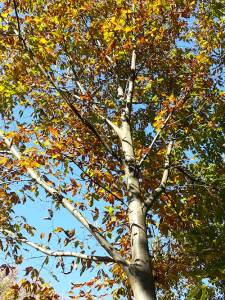 More from Don: Close up of the Mountaineer chestnut.
More from Don: Close up of the Mountaineer chestnut.
I am still a big believer in the backcross breeding program.
Don’t believe anything you read about it not being a viable option anymore. There are a lot of inaccuracies in how the data is being presented and interpreted.
In my opinion, we are still on course for a blight resistant American chestnut tree. Patience is required!
Our natural world and our ultimate survival is being threatened…
from climate change, deforestation, human encroachment and now from genetic engineering (biotechnology) that is being promoted/marketed as “green” solutions to our energy, food, and quality of life needs. These are all-inclusive false solutions to eliminate the threats/damage from pests, pathogens, and for climate change adaptation. In reality, these are a consolidation of power and ownership/control created to exploit nature in a highly obstructive and disruptive path that may instead accelerate the collapse of earth’s delicate natural balance that sustains all life.
Webinar Who is Behind the Genetically Engineered American Chestnut
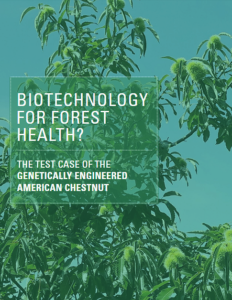
Click Image to read the 48-page report written by Anne Petermann (GJEP) and Rachel Smolker (Biofuel Watch) Campaign to Stop GE Trees Steering Committee – Click here to Read the 2-page executive summary.

